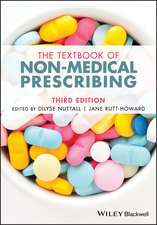Fundamentals of Machine Learning and Deep Learning in Medicine
Autor Reza Borhani, Soheila Borhani, Aggelos K. Katsaggelosen Limba Engleză Paperback – 19 noi 2022
Expert authors remove the veil of unnecessary complexity that often surrounds machine learning and deep learning by employing a narrative style that emphasizes intuition in place of abstract mathematical formalisms, allowing them to strike a delicate balance between practicality and theoretical rigor in service of facilitating the reader’s learning experience. Topics covered in the book include: mathematical encoding of medical data, linear regression and classification, nonlinear feature engineering, deep learning, convolutional and recurrent neural networks, and reinforcement learning. Each chapter ends with a collection of exercises for readers to practice and test their knowledge.
This is an ideal introduction for medical students, professionals, and researchers interested in learning more about machine learning and deep learning. Readers who have taken at least one introductory mathematics course at the undergraduate-level (e.g., biostatistics or calculus) will be well-equipped to use this book without needing any additional prerequisites.
Preț: 583.96 lei
Preț vechi: 614.69 lei
-5% Nou
Puncte Express: 876
Preț estimativ în valută:
111.74€ • 116.67$ • 92.27£
111.74€ • 116.67$ • 92.27£
Carte tipărită la comandă
Livrare economică 11-17 aprilie
Preluare comenzi: 021 569.72.76
Specificații
ISBN-13: 9783031195013
ISBN-10: 3031195019
Pagini: 196
Ilustrații: XI, 196 p. 122 illus., 89 illus. in color. With online files/update.
Dimensiuni: 155 x 235 mm
Greutate: 0.36 kg
Ediția:1st ed. 2022
Editura: Springer International Publishing
Colecția Springer
Locul publicării:Cham, Switzerland
ISBN-10: 3031195019
Pagini: 196
Ilustrații: XI, 196 p. 122 illus., 89 illus. in color. With online files/update.
Dimensiuni: 155 x 235 mm
Greutate: 0.36 kg
Ediția:1st ed. 2022
Editura: Springer International Publishing
Colecția Springer
Locul publicării:Cham, Switzerland
Cuprins
Introduction.- Mathematical Modeling of Medical Data.- Linear Learning.- Nonlinear Learning.- Multi-Layer Perceptrons.- Convolutional Neural Networks.- Recurrent Neural Networks.- Autoencoders.- Generative Adversarial Networks.- Reinforcement Learning.
Notă biografică
Reza Borhani, PhD is a seasoned machine learning consultant and engineer with a depth of experience developing AI solutions for companies in the healthcare and technology sectors. He has developed and taught a wide range of undergraduate-and graduate-level courses on machine learning, deep learning, reinforcement learning, and mathematical optimization at Northwestern University where he also holds an adjunct faculty position.
Soheila Borhani, MD is a physician-scientist with extensive clinical experience in various in-patient and out-patient settings. Her medical research interests lie in the areas of cancer biology, translational oncology, bioinformatics, and the application of artificial intelligence to cancer diagnostics and prognostics. She has served as editor and reviewer for a number of peer-reviewed journals in the field, and has organized short-courses on the topic of AI in medicine.Aggelos K. Katsaggelos, PhD is the Joseph Cummings Professor in Electrical and Computer Engineering (courtesy Computer Science and Radiology), and the deputy director of the Center for Computational Imaging and Signal Analytics in Medicine and co-lead of the Augmented Intelligence in Medical Imaging Program under the Institute for Augmented Intelligence in Medicine at Feinberg School of Medicine at Northwestern University. He is a Fellow of the Institute of Electrical and Electronics Engineers (IEEE), SPIE, the European Association for Signal Processing (EURASIP), and the Optical Society of America (OSA).
Soheila Borhani, MD is a physician-scientist with extensive clinical experience in various in-patient and out-patient settings. Her medical research interests lie in the areas of cancer biology, translational oncology, bioinformatics, and the application of artificial intelligence to cancer diagnostics and prognostics. She has served as editor and reviewer for a number of peer-reviewed journals in the field, and has organized short-courses on the topic of AI in medicine.Aggelos K. Katsaggelos, PhD is the Joseph Cummings Professor in Electrical and Computer Engineering (courtesy Computer Science and Radiology), and the deputy director of the Center for Computational Imaging and Signal Analytics in Medicine and co-lead of the Augmented Intelligence in Medical Imaging Program under the Institute for Augmented Intelligence in Medicine at Feinberg School of Medicine at Northwestern University. He is a Fellow of the Institute of Electrical and Electronics Engineers (IEEE), SPIE, the European Association for Signal Processing (EURASIP), and the Optical Society of America (OSA).
Textul de pe ultima copertă
This book provides an accessible introduction to the foundations of machine learning and deep learning in medicine for medical students, researchers, and professionals who are not necessarily initiated in advanced mathematics but yearn for a better understanding of this disruptive technology and its impact on medicine. Once an esoteric subject known to few outside of computer science and engineering departments, today artificial intelligence (AI) is a widely popular technology used by scholars from all across the academic universe. In particular, recent years have seen a great deal of interest in the AI subfields of machine learning and deep learning from researchers in medicine and life sciences, evidenced by the rapid growth in the number of articles published on the topic in peer-reviewed medical journals over the last decade. The demand for high-quality educational resources in this area has never been greater than it is today, and will only continue to grow at a rapid pace.
Expert authors remove the veil of unnecessary complexity that often surrounds machine learning and deep learning by employing a narrative style that emphasizes intuition in place of abstract mathematical formalisms, allowing them to strike a delicate balance between practicality and theoretical rigor in service of facilitating the reader’s learning experience. Topics covered in the book include: mathematical encoding of medical data, linear regression and classification, nonlinear feature engineering, deep learning, convolutional and recurrent neural networks, and reinforcement learning. Each chapter ends with a collection of exercises for readers to practice and test their knowledge.
This is an ideal introduction for medical students, professionals, and researchers interested in learning more about machine learning and deep learning. Readers who have taken at least one introductory mathematics course at the undergraduate-level (e.g., biostatistics or calculus) will be well-equipped to use this book without needing any additional prerequisites.
Expert authors remove the veil of unnecessary complexity that often surrounds machine learning and deep learning by employing a narrative style that emphasizes intuition in place of abstract mathematical formalisms, allowing them to strike a delicate balance between practicality and theoretical rigor in service of facilitating the reader’s learning experience. Topics covered in the book include: mathematical encoding of medical data, linear regression and classification, nonlinear feature engineering, deep learning, convolutional and recurrent neural networks, and reinforcement learning. Each chapter ends with a collection of exercises for readers to practice and test their knowledge.
This is an ideal introduction for medical students, professionals, and researchers interested in learning more about machine learning and deep learning. Readers who have taken at least one introductory mathematics course at the undergraduate-level (e.g., biostatistics or calculus) will be well-equipped to use this book without needing any additional prerequisites.
Caracteristici
Offers an accessible introduction to deep learning in medicine Covers artificial intelligence topics with a focus on application and visualization Includes over 100 end of chapter exercises

















